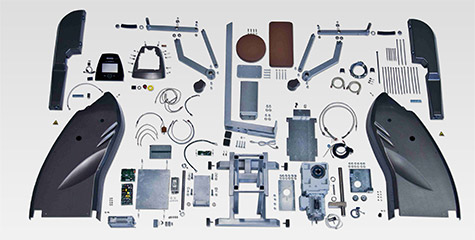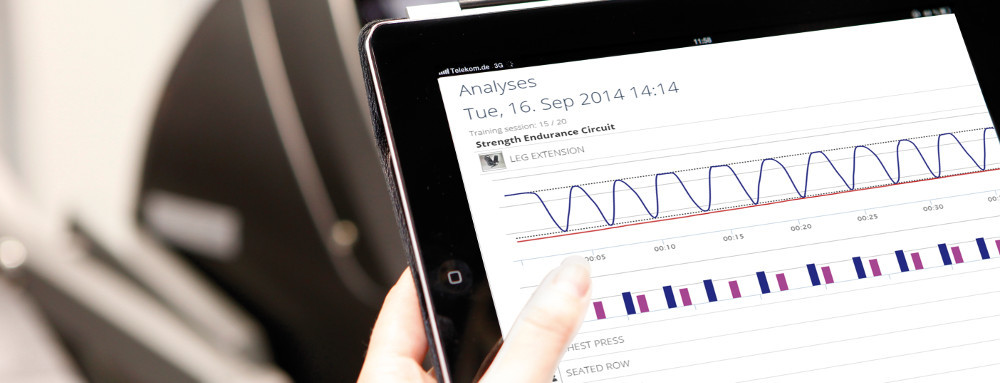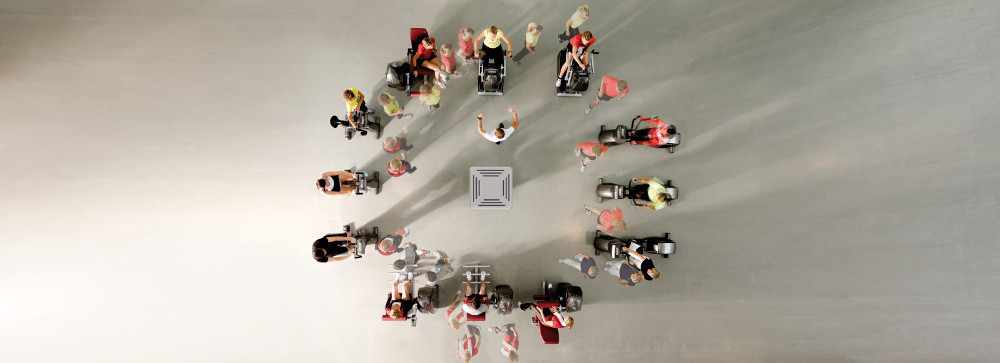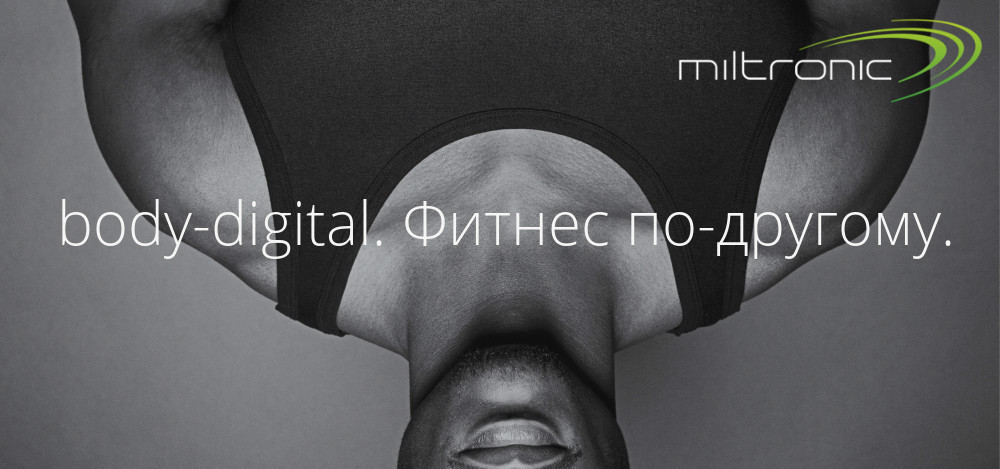What will happen if we combine IT and sports medicine?
It will turn out what we called “body-digital fitness” - a high-intensity interval circular training on electronic simulators. About us already told on YaC'e . But there is a fair amount of misconceptions. In order not to create new illusions, I will tell you everything in order.

Photo of a disassembled simulator to attract attention
In 2000, the German company milon launched a line of electronic power simulators. The use of electric motors to create a load gives 3 direct advantages:
But, in addition, the electronic foundation lays the "extensible architecture." Trainers get new chips due to small improvements or even firmware upgrades. True, the Germans began to use it only a decade later, but now they release a new feature every year.

In 2012, milon added an ethernet port to the simulators and began to store the settings on the server. And in 2013, he released the cloud (of course) milon CARE application. The main thing that it brought is the digitization of movements for analyzing the quality of exercise and overall progress. For example, in the photo above - the schedule of movement on the simulator. It shows that the trainee makes big pauses at the top point. Another example: a too accurate schedule would indicate that it is time to increase the load.
Well, of course, now you can measure in the amount of calories burned. Where without it.
In 2014, new training modes were added to the firmware.
In adaptive mode, the simulator analyzes the applied force and on the fly adjusts the load so as to squeeze the maximum in the allotted time.
In isokinetic mode, the roller moves with uniform speed at any resistance from the trainee. It turns out an analogue of static exercises, only with the strengthening of the ligaments.

But all this electronics in simulators would be interesting only to those who are turned either on electronics or on simulators. milon, together with the University of Cologne, Sports and Fitness, developed a training system for profit for ordinary people. They adapted the idea of crossfit for any physical training.
Exercise machines are put in a circle and simultaneously count the intervals of work and rest. During the "rest", each trainee moves to the next simulator in a circle, inserts an RFID card and waits for the "work" to begin. Thus, a “conveyor” without queues is created, which can be completely completed in 35 minutes. And due to the high-intensity rhythm and study of 6 large muscle groups, you need to train once every 4-5 days.
At this place, special competitions often begin on the topic of why this should not work. I can only say, after which I myself stopped comparing this system with classical fitness. We measured the metabolic rate before and after training - it rises by 48 hours. A trip to the “rocking chair” also speeds up the metabolism by 3-4 hours. Those. for the body, the process is completely different. Which, of course, does not prove its effectiveness. I had to make sure of this myself. =) It works.

- In 2013, the first club with milon equipment has opened in Russia miltronic . Later, three more network clubs opened. And in 2015, a new team took up the promotion of the network. The first thing we started with was 3 months to figure out how the German training system works from a practical and physiological point of view. The classic fitness club for many with whom we had to talk is something like an entertainment center with a pool, iron and saunas. To move away from this image, we came up with our name for our workouts - “body-digital fitness”. I invite readers of Giktayms to try it in one of 4 clubs in Moscow, Kazan and Samara.
Immediately answer the first question. In Samara and Kazan, the annual subscription will cost 19900. In Moscow - 69900 on Tsvetnoy Boulevard and 59900 on Park Kultury (right next to Yandex). In the latter, you can now buy a daily card for 39900.

Photo of a disassembled simulator to attract attention
First about simulators
In 2000, the German company milon launched a line of electronic power simulators. The use of electric motors to create a load gives 3 direct advantages:
- The ability to set the reverse (eccentric) load above the direct (concentric) - i.e. "Lower" more weight than "lift". Due to this, 30% more muscle fibers are included in the work.
- Limit the amplitude of movement individually for each trainee, thus protecting from stretching.
- Remember and automatically set the amplitude, load and position settings. Like electrically adjustable seats in a car.
But, in addition, the electronic foundation lays the "extensible architecture." Trainers get new chips due to small improvements or even firmware upgrades. True, the Germans began to use it only a decade later, but now they release a new feature every year.
So where without your cloud?

In 2012, milon added an ethernet port to the simulators and began to store the settings on the server. And in 2013, he released the cloud (of course) milon CARE application. The main thing that it brought is the digitization of movements for analyzing the quality of exercise and overall progress. For example, in the photo above - the schedule of movement on the simulator. It shows that the trainee makes big pauses at the top point. Another example: a too accurate schedule would indicate that it is time to increase the load.
Well, of course, now you can measure in the amount of calories burned. Where without it.
Training Modes
In 2014, new training modes were added to the firmware.
In adaptive mode, the simulator analyzes the applied force and on the fly adjusts the load so as to squeeze the maximum in the allotted time.
In isokinetic mode, the roller moves with uniform speed at any resistance from the trainee. It turns out an analogue of static exercises, only with the strengthening of the ligaments.
35 minutes 6 times a month

But all this electronics in simulators would be interesting only to those who are turned either on electronics or on simulators. milon, together with the University of Cologne, Sports and Fitness, developed a training system for profit for ordinary people. They adapted the idea of crossfit for any physical training.
Exercise machines are put in a circle and simultaneously count the intervals of work and rest. During the "rest", each trainee moves to the next simulator in a circle, inserts an RFID card and waits for the "work" to begin. Thus, a “conveyor” without queues is created, which can be completely completed in 35 minutes. And due to the high-intensity rhythm and study of 6 large muscle groups, you need to train once every 4-5 days.
At this place, special competitions often begin on the topic of why this should not work. I can only say, after which I myself stopped comparing this system with classical fitness. We measured the metabolic rate before and after training - it rises by 48 hours. A trip to the “rocking chair” also speeds up the metabolism by 3-4 hours. Those. for the body, the process is completely different. Which, of course, does not prove its effectiveness. I had to make sure of this myself. =) It works.
Body-digital fitness in Russia

- In 2013, the first club with milon equipment has opened in Russia miltronic . Later, three more network clubs opened. And in 2015, a new team took up the promotion of the network. The first thing we started with was 3 months to figure out how the German training system works from a practical and physiological point of view. The classic fitness club for many with whom we had to talk is something like an entertainment center with a pool, iron and saunas. To move away from this image, we came up with our name for our workouts - “body-digital fitness”. I invite readers of Giktayms to try it in one of 4 clubs in Moscow, Kazan and Samara.
Immediately answer the first question. In Samara and Kazan, the annual subscription will cost 19900. In Moscow - 69900 on Tsvetnoy Boulevard and 59900 on Park Kultury (right next to Yandex). In the latter, you can now buy a daily card for 39900.
